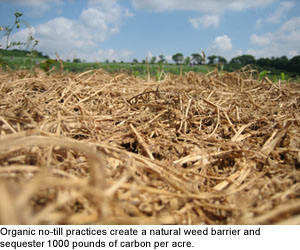(Beyond Pesticides, December 7, 2009) In an investigation and legal case that dragged on for almost four years, one of the largest organic cattle producers in the United States, Promiseland Livestock, LLC, is suspended from organic commerce, along with its owner and key employees, for four years. The penalty is part of an order issued by administrative law judge Peter Davenport in Washington, DC on November 25, 2009, a multimillion dollar operation with facilities in Missouri and Nebraska, including over 13,000 acres of crop land, and managing 22,000 head of beef and dairy cattle, had been accused of multiple improprieties in formal legal complaints, including not feeding organic grain to cattle, selling fraudulent organic feed and “laundering” conventional cattle as organic.
“We are pleased that justice has been served in the Promiseland matter,” said Mark A. Kastel, Senior Farm Policy Analyst for the Wisconsin-based Cornucopia Institute. Scrutiny from Cornucopia, one of the industry’s most aggressive independent watchdogs, was part of the genesis for the comprehensive USDA investigation and subsequent legal proceedings.
Promiseland became the focus of Cornucopia’s investigation into giant factory farms, milking thousands of cows that were allegedly operating illegally. Promiseland sold thousands of dairy cows to giant factory dairy farms owned by Dean Foods (Horizon Organic), Natural Prairie Dairy in Texas and Aurora Dairy based in Colorado. Aurora and Natural Prairie supply private-label, store-brand milk for Wal-Mart, Costco, Target and major supermarket chains such as HEB, Safeway and Harris Teeter.

Image by Environmental News Network
“It appears that it was the investigation into improprieties by Aurora that finally led to the hammer coming down on Promiseland,” Mr. Kastel observed. Aurora operates five dairies in Texas and Colorado and was found by USDA investigators to have “willfully” violated 14 tenets of federal organic regulations in 2007. However, Bush administration officials let the $100 million corporate dairy continue in operation under a one-year probation.
“It’s sad that the civil servants at the USDA, who had recommended Aurora be decertified, were overruled,” Mr. Kastel lamented. “They should have been banned from organic commerce the same way Promiseland, and its owner Tony Zeman, now have been.”
Although Cornucopia has praise for the professionalism of law enforcement agents at the USDA, and the career staff at the National Organic Program (NOP), who carried out the Aurora and Promiseland investigations, the farm policy research group has harshly criticized past management at the USDA which allowed Promiseland, and Aurora, to operate illegally for years.
“From formal legal complaints that we filed, Bush Administration officials at the USDA were alerted, starting in January 2005, to the alleged improprieties by massive factory farms masquerading as organic,” said Will Fantle, Research Director for The Cornucopia Institute.
Documents secured under the Freedom of Information Act (FOIA) by The Cornucopia Institute indicate that the initial investigation was squashed for political reasons by Barbara Robinson, Ph.D., who until recently directed the USDA’s organic program.
“It is inexcusable that these improprieties took place for so long and that justice was delayed,” said Gary Cox, an attorney who represents Cornucopia. “Ethical organic dairy farmers have been placed at a distinct competitive disadvantage and consumers were obviously taken advantage of.”
An investigation by the Office of Inspector General at the USDA, focusing in part on the relationship between Dr. Robinson and prominent agribusiness lobbyist and lawyer Jay Friedman, was profiled in a July 3, 2009 Washington Post story. Mr. Friedman, in addition to representing Aurora and Dean Foods, also was the lawyer for Promiseland when they were targeted by the USDA for investigation.
New documents made public have prompted Cornucopia to prepare additional legal complaints asking the USDA to focus attention now on Quality Assurance International (QAI), the certifier for Promiseland when many of the alleged abuses took place.
“This is not the first time QAI has been suspected of incompetence or improperly accommodating corporate agribusiness,” said Mr. Fantle. The Robinson, Friedman and QAI connection is part of an investigation by the USDA’s Inspector General. QAI also certifies portions of Aurora’s operation and Dean Foods’ corporate-owned industrial dairies.
“However grim it sounds, this investigation and the legal proceeding illustrate that if organic stakeholders are persistent, the system works,” Mr. Kastel said.
Cornucopia and other organic policy groups have been delighted by what they have called a “decisive shift” that has taken place since Obama administration officials have taken over at the USDA and its organic program. At a recent industry meeting in Washington, D.C., Miles McEvoy, USDA Deputy Administrator and the new director of the National Organic Program, stated emphatically that we were now entering the “age of enforcement” at the NOP.
“We started asking for new management at the organic program in 2004,” said Mr. Kastel. “We had suggested that they go outside of the Department to gain the needed expertise from someone who was universally respected by participants in the organic industry. We couldn’t have asked for a more qualified candidate than Mr. McEvoy.”
In addition to investigating QAI, Cornucopia has formally asked USDA Secretary Tom Vilsack to reopen the Aurora matter, alleging that the consent agreement allowing their probation included illegally favorable provisions. The farm policy group also asked that complaints involving Dean Foods and its Horizon label, which had languished under the Bush administration since early 2005, now also be actively investigated by the new administration.
“We think that organic consumers and the family farmers who have built this industry have good reason to be optimistic and confident that from this point forward, when they see the organic seal on a product, they know that the public servants in Washington share their steadfast desire to maintain the integrity of the organic label,” Mr. Fantle stated.
Beyond Pesticides is a member of the National Organic Coalition (NOC), and recently, Jay Feldman, director of Beyond Pesticides, was appointed to the National Organic Standards Board (NOSB). Organic agriculture embodies an ecological approach to farming that does not rely on or permit toxic pesticides, chemical fertilizers, genetically modified organisms, antibiotics, sewage sludge, or irradiation. Instead of using these harmful products and practices, organic agriculture utilizes techniques such as cover cropping, crop rotation, and composting to produce healthy soil, prevent pest and disease problems, and grow healthy food and fiber.
Beyond Pesticides supports organic agriculture as effecting good land stewardship and a reduction in hazardous chemical exposures for workers on the farm. The pesticide reform movement, citing pesticide problems associated with chemical agriculture, from groundwater contamination and runoff to drift, views organic as the solution to a serious public health and environmental threat. For more information on organic agriculture, see Beyond Pesticides’ Organic Program page.
Source: The Cornucopia Institute

















